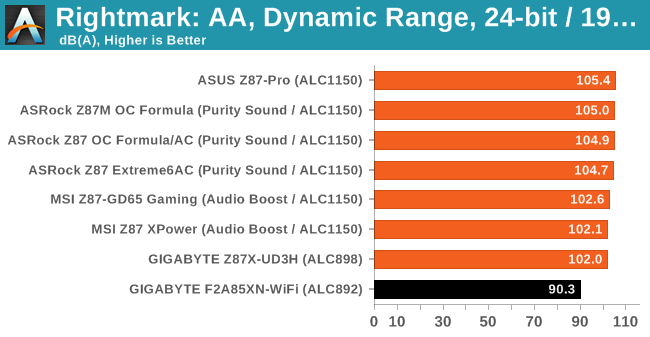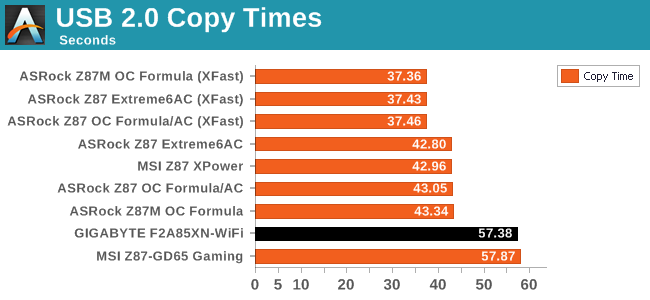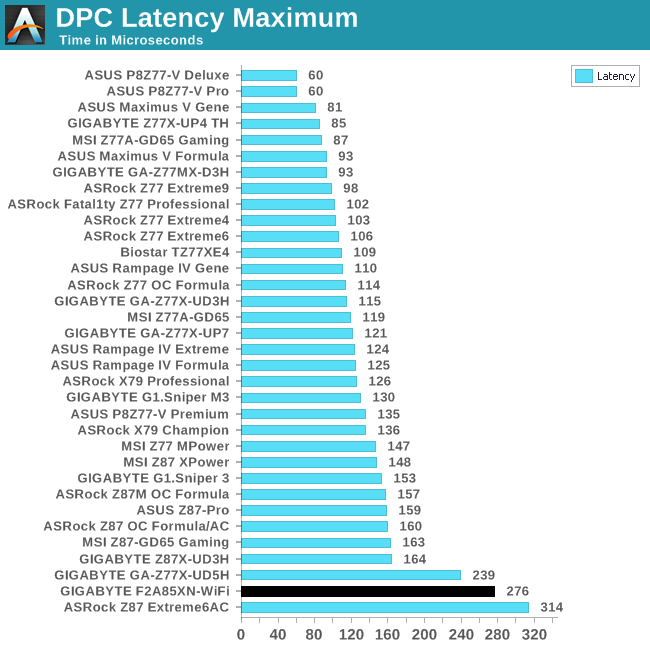GIGABYTE F2A85XN-WiFi Review: FM2 and Richland in mini-ITX
by Ian Cutress on August 21, 2013 10:00 AM ESTSystem Benchmarks
Rightmark Audio Analyzer 6.2.5
In part due to reader requests, we are pleased to include Rightmark Audio Analyzer results in our benchmark suite. The premise behind Rightmark:AA is to test the input and output of the audio system to determine noise levels, range, harmonic distortion, stereo crosstalk and so forth. Rightmark:AA should indicate how well the sound system is built and isolated from electrical interference (either internally or externally). For this test we connect the Line Out to the Line In using a short six inch 3.5mm to 3.5mm high-quality jack, turn the OS speaker volume to 100%, and run the Rightmark default test suite at 192 kHz, 24-bit. The OS is tuned to 192 kHz/24-bit input and output, and the Line-In volume is adjusted until we have the best RMAA value in the mini-pretest. We look specifically at the Dynamic Range of the audio codec used on board, as well as the Total Harmonic Distortion + Noise.


Using the Realtek ALC892 means we do not get full support on 24-bit 192 kHz, resulting in 16-bit being the max options in our OS setup. Nevertheless we were able to run the test at 24-bit, resulting in a reasonable THD+N, although the dynamic range is not comparable to some of the higher Realtek solutions.
USB Backup
For this benchmark, we run CrystalDiskMark to determine the ideal sequential read and write speeds for the USB port using our 240 GB OCZ Vertex3 SSD with a SATA 6 Gbps to USB 3.0 converter. Then we transfer a set size of files from the SSD to the USB drive using DiskBench, which monitors the time taken to transfer. The files transferred are a 1.52 GB set of 2867 files across 320 folders – 95% of these files are small typical website files, and the rest (90% of the size) are the videos used in the WinRAR test. In an update to pre-Z87 testing, we also run MaxCPU to load up one of the threads during the test which improves general performance up to 15% by causing all the internal pathways to run at full speed.


Despite using MaxCPU in our test to wake up the CPU and the relevant parts of the motherboard, we get performance similar to the Z87-GD65 Gaming on USB 2.0 and USB 3.0 performance is slower than Intel.
DPC Latency
Deferred Procedure Call latency is a way in which Windows handles interrupt servicing. In order to wait for a processor to acknowledge the request, the system will queue all interrupt requests by priority. Critical interrupts will be handled as soon as possible, whereas lesser priority requests, such as audio, will be further down the line. So if the audio device requires data, it will have to wait until the request is processed before the buffer is filled. If the device drivers of higher priority components in a system are poorly implemented, this can cause delays in request scheduling and process time, resulting in an empty audio buffer – this leads to characteristic audible pauses, pops and clicks. Having a bigger buffer and correctly implemented system drivers obviously helps in this regard. The DPC latency checker measures how much time is processing DPCs from driver invocation – the lower the value will result in better audio transfer at smaller buffer sizes. Results are measured in microseconds and taken as the peak latency while cycling through a series of short HD videos - under 500 microseconds usually gets the green light, but the lower the better.

As mentioned previously in the review, having ET6 enabled causes DPC Latency spikes every 3 seconds or so as the software polls all the sensors on the motherboard. With this disabled, we still get a higher DPC Latency score than most of the motherboards we have tested, but it still under a 500 microsecond ceiling. Ideally we really want it under 200, or 100 at best.










31 Comments
View All Comments
IanCutress - Wednesday, August 21, 2013 - link
The motherboard manufacturer has options when deciding which digital display outputs are put on the motherboard itself. Typically we see HDMI, DP and DVI-D, though as I mention in comparison to other motherboards, some manufacturers can switch up the DP to a HDMI like this motherboard here. Other manufacturers will only use two digital displays (HDMI/DVI-D or DP/HDMI) and take the VGA from the chipset. I've never used a DP monitor in my personal life (I used DP for the 4K article), so I guess I would prefer multiple HDMI ports to rig up a couple of 1080p monitors. Manufacturers have an option of a DVI-I (combined DVI-D and VGA), although few actually do so.I happen to be working with a mini-ITX motherboard that goes along all three digital displays (HDMI/DP) with the combination DVI-I right now :)
Ian
geok1ng - Wednesday, August 21, 2013 - link
Please clarify me this point: you mean this mobo can run 3 monitors using cheap HDMI>DVI adapters at the same time, for example, in stock market/online poker?DanNeely - Wednesday, August 21, 2013 - link
AFAIK AMD hasn't made any GPUs (discrete or integrated) that have 3 legacy (VGA/DVi/HDMI) clock generators; as a result you'd need an active adapter. Intel's the same; with only some of nVidia's higher end cards supporting 3 non-DP displays.thatbox - Wednesday, August 21, 2013 - link
My Radeon 5770 does that, if that counts as AMD.DanNeely - Friday, August 23, 2013 - link
AFAIK all of those cards just put the active displayport to HDMI/etc converter on the card instead of requiring you to buy a dongle. The CPU chip itself is still limited to two legacy outputs.thatbox - Wednesday, August 21, 2013 - link
Had to check to see how everything was plugged in. None of my monitors has DP (the most recent one was made in 2006). One CRT (1920x1440x75Hz) using the DVI output with a VGA adapter, one LCD (1280x1024x60Hz) using the DP output with a DVI adapter, and one LCD (1920x1200x60Hz) using the HDMI output with a DVI adapter. I guess maybe the DP>DVI adapter could be active, if it can be active without being powered, but two a year and a half ago it was like twenty bucks as opposed to the sixty or seventy or more most others were and everything works fine. It was not a big a deal as the scary research I'd done suggested it would be.paperwastage - Thursday, August 22, 2013 - link
only the active DP->dual-link DVI is expensive(>$60) and typically needs a power source (via USB)the active DP->single-link DVI has been around $20-$30 for the past few years now, don't need power source. I remember getting mine for $30 in 2010
paperwastage - Thursday, August 22, 2013 - link
AMD itself hasn't made any reference design for 3 legacy clock, but it's partners have (though the demand is weak)eg: Sapphire Flex - see only 2 "in-stock" versions on newegg
http://www.sapphiretech.com/Flex/FleX_Eng_apply.ht...
GonzaloMin - Wednesday, August 21, 2013 - link
Love my job, since I've been bringing in $82h… I sit at home, music playing while I work in front of my new iMac that I got now that I'm making it online. (Home more information)http://goo.gl/UDMcRU
meacupla - Wednesday, August 21, 2013 - link
dual HDMI is probably for HDMI TV and HDMI receiver.not that DVI or DP can't be converted to HDMI, at extra hassle for the end user, so DP would be nice.